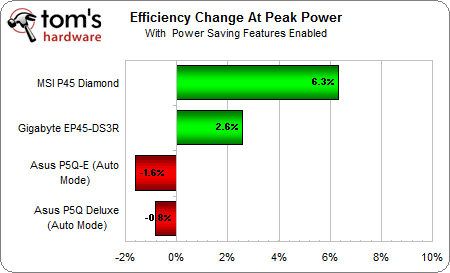Power-Saving Motherboards: Fact Or Fiction?
Efficiency Summary
Here, we summarize the differences in power consumption at idle and peak processor states for the four motherboards that offer power-saving features. Most of the results are disappointing—only one motherboard provides a measurable benefit on the processor we used in our tests.

The MSI P45 Diamond manages to save a bit more than eight percent of the power consumption when the test system runs in idle under Windows Vista. The Asus motherboards save only about one percent, which is negligible in light of the roughly 90 W total system power. The Gigabyte board reached 2.2 percent power savings in idle. Clearly, most motherboards cannot realize power savings in idle with the processor we use. We might get different results with a high-end quad core processor—but we’re interested in efficient systems, and quad-core processors don’t quite fit that bill.

The results are even more disappointing at processor peak power. We use Prime95 to stress the Core 2 Duo E7200, which in turn requires even more power on the Asus motherboards once the power-saving features are enabled. The MSI and Gigabyte products, on the other side, manage to save some power, although the MSI motherboard is at a lower total power level.
Get Tom's Hardware's best news and in-depth reviews, straight to your inbox.